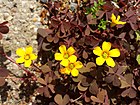Note: This is a project under development. The articles on this wiki are just being initiated and broadly incomplete. You can Help creating new pages.
Oxalis corniculata - Changeri
Changeri, is a herbaceous creeping plant. The leaves are bright green and trifoliate, flowers are bright yellow. The whole plant is edible and has a very sour taste.
Contents
- 1 Uses
- 2 Parts Used
- 3 Chemical Composition
- 4 Common names
- 5 Properties
- 6 Habit
- 7 Identification
- 8 List of Ayurvedic medicine in which the herb is used
- 9 Where to get the saplings
- 10 Mode of Propagation
- 11 How to plant/cultivate
- 12 Commonly seen growing in areas
- 13 Photo Gallery
- 14 References
- 15 External Links
Uses
Scurvy, Antidote for poison, Fever, Inflammation, Insomnia [1]
Parts Used
Chemical Composition
Common names
| Language | Common name |
|---|---|
| Kannada | Hulichikka, Changeri gida |
| Hindi | Amrulsak, Anboti, Chuka tripati |
| Malayalam | Puliyaral, Puliyarala |
| Tamil | Puliyancirukirai, Puliyankirai, Puliyarai, Puliyarani |
| Telugu | Pulichinta, Pulichintaaku, Ambotikura |
| Marathi | NA |
| Gujarathi | NA |
| Punjabi | NA |
| Kashmiri | NA |
| Sanskrit | Amlapatrika, Changeri, Shuklika |
| English | Indian sorrel |
Properties
Reference: Dravya - Substance, Rasa - Taste, Guna - Qualities, Veerya - Potency, Vipaka - Post-digesion effect, Karma - Pharmacological activity, Prabhava - Therepeutics.
Dravya
Rasa
Amla (Sour), Kashaya (Astringent)
Guna
Laghu (Light), Rooksha (Dry)
Veerya
Ushna (Hot)
Vipaka
Amla (Sour)
Karma
Vata, Kapha
Prabhava
Habit
Identification
Leaf
| Kind | Shape | Feature |
|---|---|---|
| Trifoliate | Alternate | Leaflets 0.5-1.5 x 0.6-2 cm, broadly obcordate, apex emarginate, base cuneate; petioles 1.5-3 cm long. |
Flower
| Type | Size | Color and composition | Stamen | More information |
|---|---|---|---|---|
| Bisexual | Solitary or in axillary umbels | Yellow | 10 | Peduncles 4-10 cm long; pedicels 0.5-1 cm long; bracts 2, 3-4 mm long, linear-lanceolate. |
Fruit
| Type | Size | Mass | Appearance | Seeds | More information |
|---|---|---|---|---|---|
| A capsule | 0.8-1.5 x 0.3-0.5 cm | Linear, puberulous outside | Seeds many, minute, brown. | {{{6}}} |
Other features
List of Ayurvedic medicine in which the herb is used
Where to get the saplings
Mode of Propagation
How to plant/cultivate
A weed of gardens and other moist shady areas. Grows readily from seed and roots along stem.
Commonly seen growing in areas
Tropical area, Sub tropical area
Photo Gallery
References
External Links
- Ayurvedic Herbs known to be helpful to treat Scurvy
- Ayurvedic Herbs known to be helpful to treat Antidote for poison
- Ayurvedic Herbs known to be helpful to treat Fever
- Ayurvedic Herbs known to be helpful to treat Inflammation
- Ayurvedic Herbs known to be helpful to treat Insomnia
- Herbs with Flowers used in medicine
- Herbs with Leaves used in medicine
- Herbs with common name in Kannada
- Herbs with common name in Hindi
- Herbs with common name in Malayalam
- Herbs with common name in Tamil
- Herbs with common name in Telugu
- Herbs with common name in Sanskrit
- Herbs with common name in English
- Habit - Herb
- Index of Plants which can be propagated by Seeds
- Herbs that are commonly seen in the region of Tropical area
- Herbs that are commonly seen in the region of Sub tropical area
- Herbs
- Oxalidaceae
- Ayurvedic herbs that don't have seed photos




